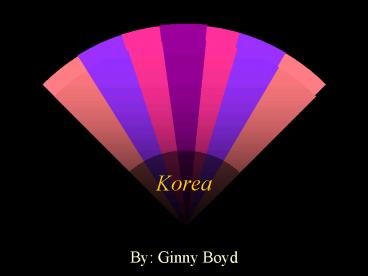Korea - PowerPoint PPT Presentation
1 / 22
Title:
Korea
Description:
Basic Indicators and Facts. Population- 22,268 (thousands) ... Fresh fruit, soybean products, legumes, ... There are no desserts, but a meal may end with fruit. ... – PowerPoint PPT presentation
Number of Views:43
Avg rating:3.0/5.0
Title: Korea
1
Korea
- By Ginny Boyd
2
Location of Korea
- The Republic of Korea is located on the Korean
Peninsula which arches a little over 600 miles
southward and slightly eastward from the
southeastern corner of the Asian continent. - Korea is bordered by Manchuria and Russia to the
north, China to the west, and Japan to the east
and south.
3
Basic Indicators and Facts
- Population- 22,268 (thousands)
- Annual number of births- 392 (thousands)
- Infant mortality rate- 23 (per 1,000 live births)
- Under 5 mortality rate- 30 (per 1,000 live
births) - Annual number of under 5 deaths- 12 (thousands)
4
Land Use in Korea
- Arable land- 14
- Permanent crops- 2
- Forests and woodland- 61
- Permanent pastures 0
- Other- 23
5
Natural Hazards in Korea
- Late spring droughts
- Severe flooding
- Typhoons in the early fall
- The nation of Korea faces its 7th year of food
shortages because of weather related problems.
6
Korean Agriculture
- Consists of rice, corn, potatoes, soybeans,
pulses cattle, pigs, pork and eggs. - The country does 520 million in exports and 960
million in imports.
7
Korean Food Guide Pyramid
- Pagoda shape
- Consist of 5 sections grains, vegetables and
fruits, milk, meat, fat and sugar - grain group- 4-5 servings
- vegetable and fruit group- 6-7 servings
- meat group 4-5 servings
- fats and sugars- limited
- milk group- 1 serving
8
Malnourishment and Healthcare
- Following the recent drought and two tropical
storms, Korea is suffering its worst food
shortage since 1997. - The UN has said that at least 810,000 tons of
food are needed to prevent a disaster. - Up to 8 million people are at risk, and some
420,000 children under age 7 already suffer from
moderate to acute malnutrition.
9
Continued
- Many basic health programs have been suspended or
drastically curtailed because of the natural
disasters and economic problems which have now
affected the country. - The result is a decrease in immunization
activities and an increase in child malnutrition.
10
Continued
- Korea reports 10,000 tuberculosis cases per year.
- There is no tuberculosis control program and the
country lacks most tuberculosis drugs. - It is also evident that there is an acute
shortage of most common drugs in hospitals and
clinics.
11
Poverty in Korea
- There is no official poverty line.
- A family is considered poor if its income or
expenditure falls below the minimum cost of
living. - 31 million people- including 12 million children-
live in households that experience hunger or the
risk of hunger.
12
Korean Food
- Traditional diets include 3 meals (breakfast,
lunch, and supper) plus snacks. - Diets include steamed rice, noodles, and broth
garnished with shellfish, meat and/or vegetables. - Fresh fruit, soybean products, legumes, and nuts
are consumed.
13
Continued
- Beverages include ginseng tea and barley water.
- Milk and other dairy products are not part of the
Korean diet.
14
Korean Meals
- Koreans like to eat together.
- When they sit down to eat, they just eat most
conversation is saved until after the meal. - Food is served once instead of in courses.
- At home, all 3 meals are basically the same with
differing side dishes.
15
Continued
- Rice is the meal- all else is secondary.
- A bowl of rice is always accompanied by an
individual serving of soup, and pnachan (side
dishes) which are put out for everyone at the
table. - Panchan includes various types of kimchI,
seasoned vegetables, fish and meat.
16
Continued
- Breakfast and dinner are the main meals lunch is
light. - Breakfast often includes a fried egg, while
dinner includes meat, stew, or extra fish. - There are no desserts, but a meal may end with
fruit. - Sweets are also absent except on traditional
holidays.
17
Continued
- Koreans use metal, bamboo, or plastic chopsticks,
in combination with a long handled, shallow spoon
to eat their meals. - Knives are strictly for food preparation in the
kitchen, so food is pre-cut into bite size pieces
or soft enough to be pulled apart with chopsticks.
18
References
- )Adams, Edward. Korea Guide. Seoul Seoul
International Publishing House, 1995. - )www.disasterrelief.org
- )www.fas.usda.gov
- )www.findarticles.com
- )Han, Suzanne. Notes on Things Korean. New
Jersey Hollym Corporation Publishers, 1995.
19
References Continued
- www.unicef.org
- )www.usc.edu
- )www.wfp.org
- )www.who.int
20
References Continued
- )Nilsen, Robert. South Korea Handbook.
California Moon Publications Inc., 1997. - )www.odci.gov
- )www.rice.edu/projects/topics/globalization/food-k
orea.htm - )www.rice.edu/projects/topics/globalization/food-s
pread-asia.htm - )www.salt.claretianpubs.org
21
References Continued
- www.lifeinkorea.com/culture/Alcohol/alcohol.cfm?Su
bjectculture - )www.lifeinkorea.com/ricecake/ricecake.cfm?subject
festival - )www.lifeinkorea.com/culture/kimchi/kimchi.cfm
- )www.lifeinkorea.com/culture/tol/tol.cfm
- )www.lifeinkorea.com/Food/index.cfm
22
References continued
- )Jin, Kim Seong. A Handbook of Korea. Seoul
Korean Overseas Information Service, 1979. - )Lee, Y., Painter, J., and Rah, J. (April).
Comparison of International Food Guide Pictorial
Representations. The Journal of the American
Dietetic Association. (102), 4. 483-489.































